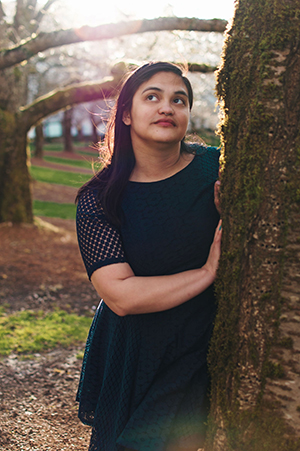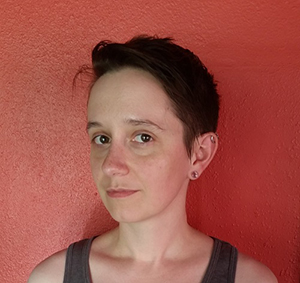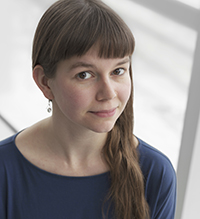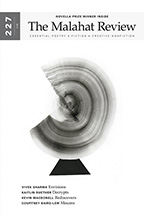Place, Time, and Water: Sasha Penn and Joanne Rixon in Conversation with Paige Lindsay
Sasha Penn and Joanne Rixon, who worked collaboratively on their story, "Cascades," which appears in The Malahat Review's Summer 2019 Issue #207, discuss the importance of place, their collaborative process, and the research they put into the story in their Q&A with Malahat Review volunteer Paige Lindsay.
 Sasha Penn is a member of the Chehalis Tribe, is very queer, and resides in Tacoma, WA. She provides sensitivity editing services for award-winning authors, and has previously worked in newspapers. Her passion is collecting shelves full of speculative fiction novels (and occasionally reading them). This is her first published piece of fiction.
Sasha Penn is a member of the Chehalis Tribe, is very queer, and resides in Tacoma, WA. She provides sensitivity editing services for award-winning authors, and has previously worked in newspapers. Her passion is collecting shelves full of speculative fiction novels (and occasionally reading them). This is her first published piece of fiction.
[Photo credit: Rachel Noonan]

Joanne Rixon was raised in a small town in the Cascade Mountains and currently lives in Tacoma, Washington. Her stories have recently appeared in Beneath Ceaseless Skies, Mysterion and Fireside Fiction. She is a member of the Dreamcrashers, and you can find her book blog at www.joannerixon.com/
It’s not often that we see a story with two author names on it. How did you come to work on “Cascades” together? In what ways does writing together change the process?
Joanne: This was the first time I’ve co-written a story, since I tend to be fiercely possessive of my writing process; it was hard for me to give up control of plot elements and themes. But of course the whole reason I brought an early draft of this story to Sasha and asked her to work on it with me was because I had faith that her perspective was what the story needed, to be a working story. And that proved true.
This was the first time I’ve tried to write a story with someone, and it was interesting. I was really pleased with our process in the end, which mostly involved me reading sentences aloud and Sasha going, “ummm maybe a different way of phrasing things…” and, “well, I don’t know if you’ve thought about it this way…” And then me taking dictation, and secretly changing things without telling her and then changing them back once I felt guilty.
Sasha: I’ve done some sensitivity readings for my Native American perspective in the past and Joanne had the idea to represent a part of what Native Americans have faced.
In the past I have recorded my voice and then replayed to get it down in writing. Joanne vastly improved my ideas and sped up the process it takes to make this story come to life.
We would spend our time talking back and forth with her at the computer typing away. I’m better at talking than I am writing – verbal thinking flows easier for me. Joanne’s description of our process is pretty accurate. Transcribing trips me up and having Joanne put things together to make sense worked out very well.
In “Cascades,” acts of racism, injustice, and violence are perpetrated against four marginalized characters. As the four characters are introduced to the reader, we learn the location of each, as well as their proximity to water. We discover that although the different voices inhabit the Tacoma area, they are dispersed across time. Would you please tell us about the importance of place, time, and water to this piece?
Joanne: Hm. This is a complicated question because a lot of this grew organically from the decision to place the story here in Tacoma, where both Sasha and I live. Way, way back there is a version of this story that is so different it’s basically a different story, because it’s set in St. Louis, where I lived for about a year. That version didn’t work. Setting it in my (our) own hometown was really important because of the topic of the story; it didn’t work if I was talking about somebody else’s trauma, you know? So, once I started working on it with Sasha, it had to be in Tacoma and then of course these locations, which are very, very close together in real life, are the locations of things that really happened here.
So it sort of organically turned into this thing where basically the same location had these similar/different events over time, and while time separated them, the location tied them back together. As for water… this is a water city. It’s a port city, our whole geography is shaped by the mountains and the water that runs off them, forms a river, and flows to the ocean. The water provides a natural continuity that kind of also sprang from that initial decision about where the story would be set.
Sasha: I belong to the “Confederated Tribe of the Chehalis Reservation,” the Chehalis Tribe, which is located in the Pacific Northwest, and I identify as a ‘coastal’ Native American. Beaches, rivers, and lakes all give me the feeling of being home – I’ve always lived near some form of water. My experience and stance are rooted here in Tacoma; it would be difficult for me to write about something without having lived through the influences.
For time and place, we wanted it to be rooted locally and I like how it branched out overall. The different parts build upon the core feeling and naturally develop through the connections.
As I was reading, I kept thinking back to the first line, "Everything in this story is true." Could you tell us a little about the research involved in writing this story?
Joanne: The Tacoma Public Library’s Main branch has a Pacific Northwest Reading Room, complete with stone staircase and vaulted ceiling, where you can find firsthand documents on everything from the Puget Sound Indian War in 1855 (including a concentration camp run by the US Army on Fox Island, a tiny bit of land in Puget Sound where these days if you have a million dollars you can buy a waterfront house built on the bones of Puyallup people who starved to death while incarcerated there), to the police shooting of Jacqueline Salyers in 2016. You can read newspapers from the 1880s, when Tacoma was renowned throughout the US for our ‘humane’ method of removing unwanted Chinese immigrants without actually shooting them or burning them alive; they call it the Tacoma Method. These days Tacoma doesn’t have a Chinatown neighborhood, but there’s a Chinese Reconciliation Park, built on the waterfront as an apology; parts of this story were literally written in that park. When we say everything in this story is true, that’s not an exaggeration!
Here are some books for further reading, if you’re interested:
-STRAW HATS, SANDALS AND STEEL: THE CHINESE IN WASHINGTON STATE, by Lorraine Hildebrand, was the source for many of the details on the Tacoma Method.
-TEARS OF INTERNMENT: THE INDIAN HISTORY OF FOX ISLAND AND THE PUGET SOUND INDIAN WAR, by Cecelia Svinth Carpenter, and her other books including LESCHI: LAST CHIEF OF THE NISQUALLIES. Svinth Carpenter was Nisqually, and her work is more reliable than other histories of the era.
-The Tacoma News Tribune has done some decent reporting on the police killing of Jacqueline Salyers, including this article: https://www.thenewstribune.com/news/local/crime/article79049822.html (which includes the important caveat that the official story is built from the accounts provided by police; JUSTICE FOR JACKIE is the group created by her family and friends in protest). The police shooting in “Cascades” is based on but not a direct re-creation of Jackie’s death, because we don’t want to be disrespectful. The story draws on many other incidents, from the death of John T. Williams on the streets of Seattle to the death of Philando Castile in Minnesota.
-As for the history of the Hilltop neighborhood, Tacoma’s segregated black neighborhood in the 1930s, I have to thank my friend Melvin Rouse, who generously let me interview him about his extended family’s history in our area, jazz clubs and church music, and being black in the liberal PNW. He loaned me JACKSON STREET AFTER HOURS: THE ROOTS OF JAZZ IN SEATTLE, by Paul De Barros. And if you’re interested in the migration of black folks to other parts of the country post-Civil War, I strongly recommend Isabel Wilkerson’s THE WARMTH OF OTHER SUNS.
Sasha: My research was mostly into my Tribe’s subset of the Salish language, which is referred to as Lushootseed. Joanne did the heavy lifting for the accuracy.
The fantastical elements in this piece are wonderfully wrought and skillfully woven into the moments of conflict throughout "Cascades." It made me think of creation myths and legends, and the power and significance of storytelling. Was there a particular myth that you had in mind while writing this story? What else inspired you to write "Cascades"?
Joanne: For me, I was inspired more by real life than by myth. I’ve done a certain amount of work as an activist and one thing that has always been so frustrating to me is the trouble I have imagining what a better world would actually be like. If you can’t even imagine where you’re going, how can you get there? There is so much historical reality in this story that the ending was impossible for me to imagine for a long time.
Maybe that’s a kind of inspiration: I knew that imagining a solution for injustice is something that feels beyond my power and so I wanted to see if it was possible.
Also, shout out to Terry Bisson’s novella FIRE ON THE MOUNTAIN, which you should absolutely read if you can get your hands on a copy, because General Harriet Tubman as the leader of a black socialist democracy built on the smoking ruins of the old American South is …just, perfection.
Sasha: There isn’t a particular myth behind this story. I grew up listening to my mom and other storytellers. We would sit quietly and learn about how we were born, about shapeshifting, our animal relatives, and how things came to be, like our ability to use fire. This story is a mix of elements and influenced from traditional Native American storytelling. Unfortunately, I don’t have any information to credit someone. These stories exist throughout the ages and take on the voice of whoever is telling them.
The four main characters in this story share a desire to "set things right." I'm continually curious, encouraged, and inspired by the different ways that people strive to "set things right" in their day-to-day lives. Do you have suggestions or resources for readers who share a similar desire to "level the playing field"?
Joanne: Well, we have to do what it’s possible to do. Here’s some practical advice: Google around to find what prisons, juvenile detention centers, immigration holding facilities, etc. exist in your area, then get on Facebook and search the names of those facilities. You’ll get all kinds of community and non-profit groups associated with them, because non-profit orgs use Facebook to organize and fundraise these days. Volunteer in a prison. It’s good for you! But, also: it’s important to acknowledge that to truly level the playing field for everyone would require drastic action to create a world that is fundamentally different than our current reality. Volunteering twice a month is nice; a just world requires revolution.
Sasha: It is more about taking action where you can. Rome wasn’t built in a day and drastic change needs a whole lot of people working together to see it happen.
What projects, either together or separately, are you working on now?
Joanne: I was just telling Sasha that she and I should start work on a new story! Something in space, maybe. For now, I’m solo-writing a novel, a second-world fantasy murder mystery with a bunch of teleportation in it. It’s quite queer, and I’m excited about it.
Sasha: I’d be down to write together again; I just feel out of my element the further we get from Native American issues. I would like to see more queer representation, and it would be great to take part in making more.
Separately I mostly do sensitivity readings. I have half-finished premises and some other ideas rattling about in my mind that haven’t made it to a page yet. When the mood strikes I also write bad poetry, none of which I want to pursue publishing.

Paige Lindsay
* * * * * * * *









